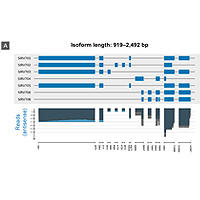SMART-Seq mRNA Long Read

SMART-Seq mRNA Long Read generates high-quality full-length barcoded cDNA from ultra-low inputs for long-read sequencing on the Oxford Nanopore Technologies (ONT) instruments. The workflow is optimized for 10 pg–100 ng high integrity total RNA (RIN >8) or 1–1,000 intact cells. Up to 96 multiplexed libraries can be prepared for single-tube ONT library preparation. Enjoy easy and convenient demultiplexing using a protocol and files provided by Takara Bio for use with Dorado from ONT.
SMART-Seq mRNA Long Read enables whole-transcriptome analysis from low-input samples using long-read sequencing. The workflow uses dT priming to generate full-length cDNA from 10 pg–100 ng high integrity total RNA (RIN >8) or directly from 1–1,000 intact cells. Subsequent cDNA amplification using barcoded primers allows the preparation of up to 96 barcoded cDNA libraries for subsequent adapter ligation and library prep for long-read sequencing on the Oxford Nanopore Technologies (ONT) platform. This strategy enables multiplexing of low-input samples for ONT library preparation, reliably generating average read lengths (N50) of ~2 kb and detecting full-length transcripts over 8 kb.
The complete protocol including cDNA synthesis, barcoding, enrichment, and pooling of barcoded cDNA for ONT library prep can be completed in one and a half days. The workflow is automation and miniaturization friendly. Sequencing data generated with this kit can easily be demultiplexed using a protocol and files provided by Takara Bio for use with Dorado from ONT.
The SMART (Switching Mechanism at 5' End of RNA Template) technology powering cDNA synthesis provides an efficient way to capture full-length transcript information, enabling analysis of transcript isoforms, gene fusions, point mutations, etc. Additionally, the highly sensitive and reproducible chemistry enables the identification of higher numbers of genes relative to other methods, even from low-input samples. The kits provide high reproducibility, even gene-body coverage, and an accurate representation of GC-rich transcripts.
Overview
- Superior sensitivity and performance for ultra-low inputs—10 pg–100 ng total RNA or 1–1,000 intact cells
- High-quality long-read sequencing data—reliably obtain average read lengths (N50) of ~2 kb, detecting full-length transcripts over 8 kb
- Seamless integration of barcodes—multiplex up to 96 samples for single-tube long-read library preparation
- Streamlined sample demultiplexing—convenient and efficient workflow for accurate sample assignment compatible with ONT's basecaller
More Information

Detect full-length isoforms from low-input (10 pg) RNA.
Additional product information
Please see the product's Certificate of Analysis for information about storage conditions, product components, and technical specifications. Please see the Product Components List to determine kit components. Certificates of Analysis and Product Components Lists are located under the Documents tab.
Enabling long-read RNA sequencing from low-input samples
Facilitating the discovery of complex isoforms and novel structural variants from 10 pg–100 ng of total RNA
SMART-Seq mRNA Long Read Demultiplexing for ONT Sequencing Data
Sign-up to access the supporting files to demultiplex and prepare your SMART-Seq mRNA Long Read sequencing data for downstream analysis.
Takara Bio USA, Inc.
United States/Canada: +1.800.662.2566 • Asia Pacific: +1.650.919.7300 • Europe: +33.(0)1.3904.6880 • Japan: +81.(0)77.565.6999
FOR RESEARCH USE ONLY. NOT FOR USE IN DIAGNOSTIC PROCEDURES. © 2025 Takara Bio Inc. All Rights Reserved. All trademarks are the property of Takara Bio Inc. or its affiliate(s) in the U.S. and/or other countries or their respective owners. Certain trademarks may not be registered in all jurisdictions. Additional product, intellectual property, and restricted use information is available at takarabio.com.





